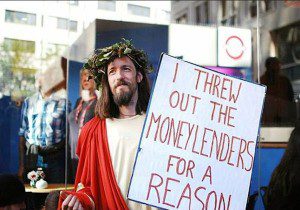| Online: | |
| Visits: | |
| Stories: |

| Story Views | |
| Now: | |
| Last Hour: | |
| Last 24 Hours: | |
| Total: | |
The Trap of Debt Economics
Guest Writer for Wake Up World
Money is a medium of exchange and the study of its use is called economics. In days gone by bartering was the order of the day. If you had corn and wanted wheat, and I had wheat and wanted corn, we would decide how much of one commodity was equivalent to the other and make an exchange on this basis. However, bartering is an awkward process because of the unwieldy items and commodities involved. Obviously, exchanges of goods would be facilitated if people used something less cumbersome as a medium of exchange such as gold or silver. If I grow wheat, by exchanging my wheat for gold it will allow me to obtain other things more conveniently when I want them. Thus metals like gold and silver became our first widely used mediums of exchange.
Once people started using gold and silver to trade goods, the need to transform these metals into standardized recognizable amounts became evident. This led to the development of rudimentary coins; whereby an authority would weigh out various quantities of these precious metals and stamp them as to purity and weight. Once this practice became common, it was only a matter of time before coins took on their characteristic disc shape and were impressed with a mint date and the likenesses of important officials. With the development of coinage, a person could exchange the fruits of their labor for coins and use them to obtain other things when convenient. During good times, some people ended up with more coins than they could use and this meant they needed a safe place to store them. This brought the goldsmith upon the scene!
Goldsmiths worked with precious metals and had safes or strongboxes within which they kept their supplies. Having this capability, it was only natural for people to take their excess coins to the goldsmith for safe keeping. Upon so doing, the goldsmith would give them a written receipt for the amount of coins being stored. Soon people realized that instead of trading coins for the things they needed, they could trade the receipts instead. Thus paper currency was born and this freed people from carrying bulky coins when they went to market.
This rudimentary monetary system worked well in small agrarian economies, but as villages turned into towns and towns into cities, a need to borrow money developed and who was better positioned to loan money than the goldsmith. Not only did he have his own money, but he also held other people’s money which was sitting in his coffers doing nothing. Of course, if the goldsmith was going to loan other people’s money, he needed to share some of the interest earned with them. This was the start of what we know of as modern banking. The goldsmiths were our first bankers. People would entrust their money to the banker/goldsmith and instead of paying him for this service, he would pay them a share of the interest he earned from loaning their money to other people. From the depositor’s and borrower’s perspective, this made sense and appears reasonable. However, appearances can be deceiving and how deceiving will soon become apparent.
Previous articles by Alan Adaschik:
- The Curse of Capitalism
- The Federal Reserve Bank: 100 Years of Deception
- The Curse of the Proud American
- Freedom and Democracy: an American Illusion?
-
Follow Wake Up World On…
[FACEBOOK]: http://www.facebook.com/joinwakeupworld (An interactive community of over 2,800,000)
[PINTEREST]: http://pinterest.com/wakeupword/
[TWITTER]: http://twitter.com/joinwakeupworld
[YOUTUBE]: http://www.youtube.com/joinwakeupworld
[GOOGLE PLUS]: https://plus.google.com/112452105795129310867/posts
[WEBSITE]: http://wakeup-world.com




